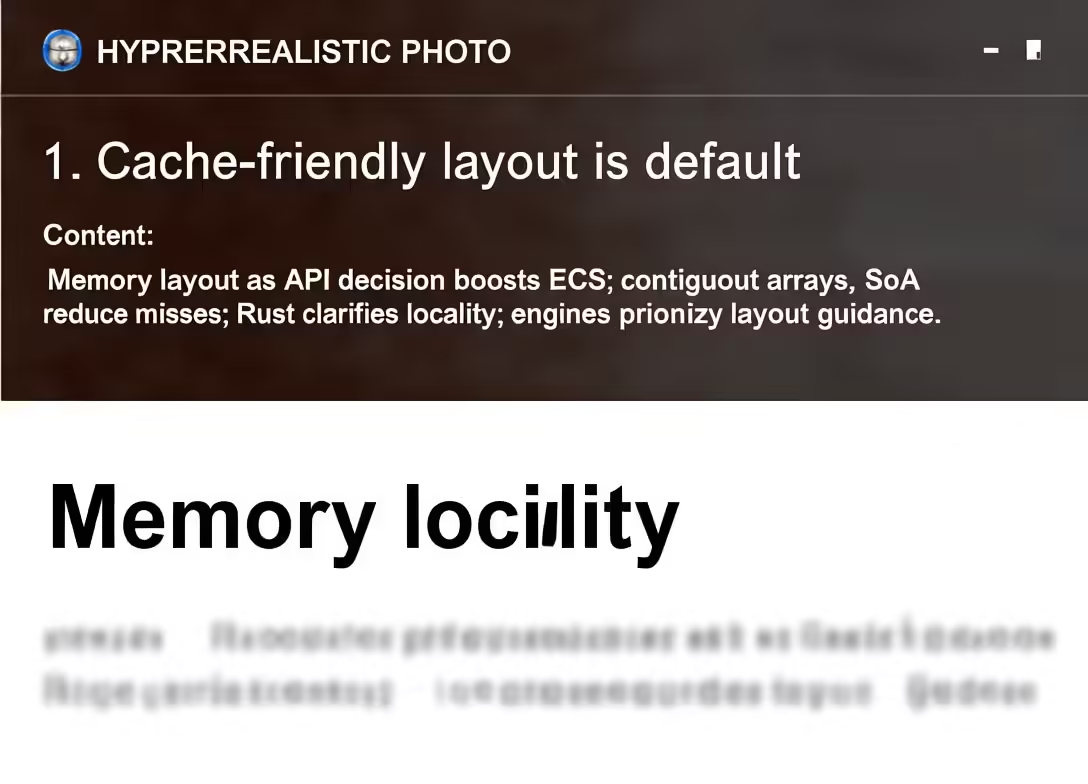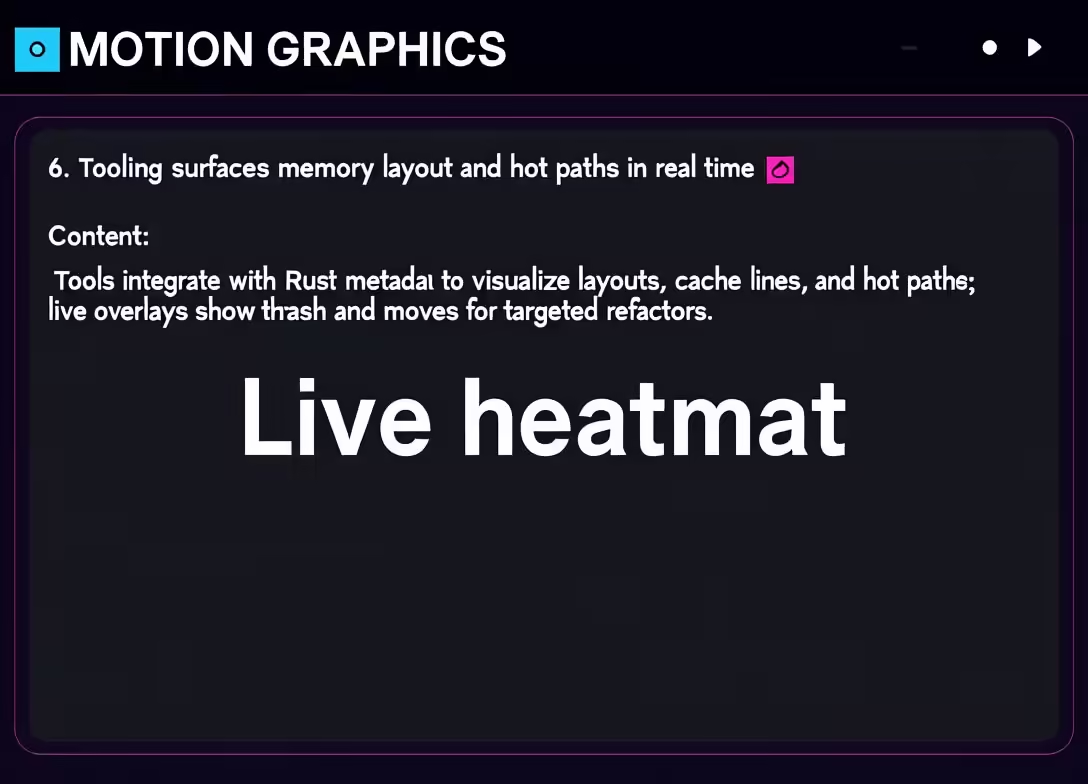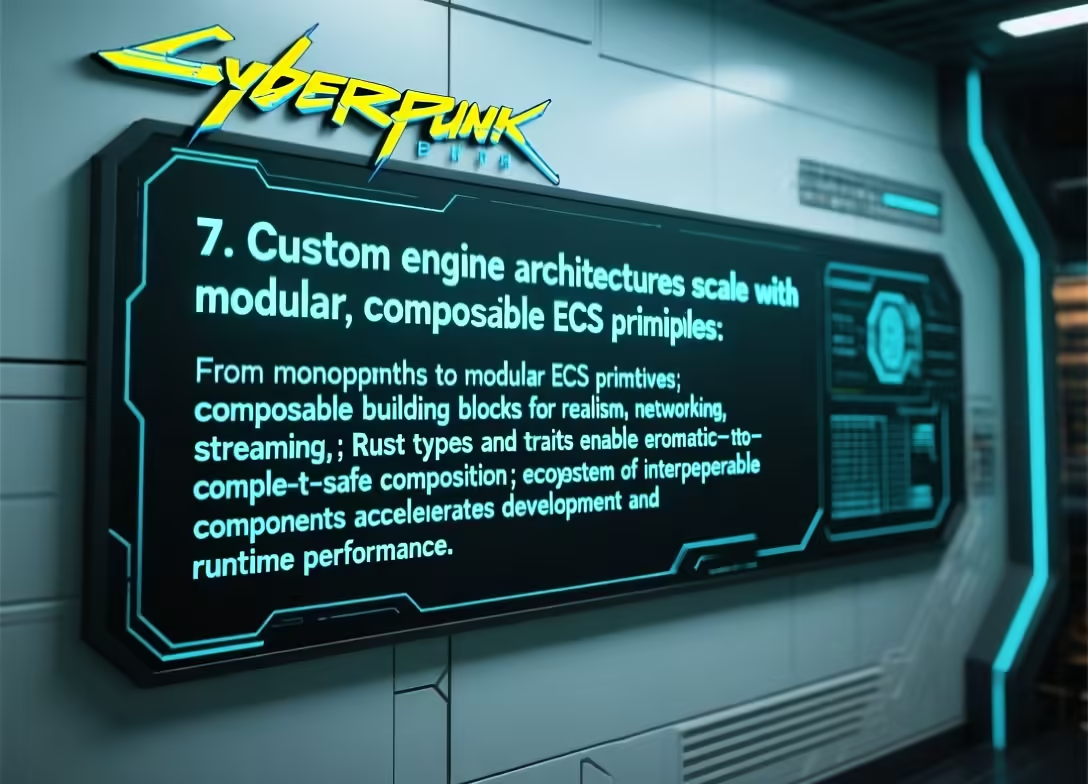7. 1. Cache-friendly memory layout becomes the default, not an optimization
Performance gains in modern ECS designs will come from treating memory layout as a first-class API decision. Systems that favor contiguous component arrays, tightly packed archetypes, and SoA (Structure of Arrays) patterns will reduce CPU cache misses and branch mispredictions, delivering consistent frame-time improvements.
Rust’s ownership and lifetimes encourage explicit data ownership, which makes it easier to reason about component locality and prefetching behavior. Expect libraries and tutorials to prioritize memory layout strategies as primary guidance for any new engine rather than optional tuning advice.
() (Source)

6. 2. Hybrid component storage models will dominate for versatility
Rigid choices—component-per-table or global sparse sets—will give way to hybrid storage that adapts per-component based on size, update frequency, and access patterns. Small, hot components will live in packed arrays; bulky or rare components will use indirection or chunked pages.
This strategy balances memory layout and update cost while maintaining high throughput in systems that process millions of entities. Tooling will surface heuristics so developers can choose storage strategies with measurable trade-offs rather than guesswork.
Such hybrid approaches will be central to pushing Rust Entity Component System performance boundaries.

5. 3. More ergonomic zero-cost concurrency for system execution
Concurrency is no longer optional for real-time engines. Rust’s fearless concurrency model makes fine-grained parallelism safer, enabling systems to run simultaneously when component read/write permissions allow.
Future ECS runtimes will provide declarative parallelism: safe, zero-cost concurrency primitives that automatically detect and schedule non-conflicting systems. The result: higher utilization of multi-core CPUs without sacrificing determinism or developer sanity—key for large-scale game engine development and simulation tasks.

4. 4. Data-oriented design principles embedded in APIs and docs
Data-oriented design will be more than a blog post; it will be encoded into libraries and examples. Expect ECS frameworks to ship with default patterns that guide developers toward contiguous component layouts, cache-aligned allocations, and batch-friendly update loops.
Documentation and templates will highlight common performance pitfalls—false sharing, poor iteration order, and unnecessary indirection—turning advanced concepts into routine engineering choices. This shift will accelerate adoption of best practices across the Rust and game engine communities, improving baseline Rust Entity Component System performance.

3. 5. Micro-benchmarks evolve into scenario-based benchmarking
Benchmarking will move away from isolated micro-benchmarks to larger, scenario-based tests that mimic actual game workloads: streaming worlds, large hierarchical updates, and mixed AI/physics loops. These benchmarks will measure throughput, tail-latency, and memory overhead to provide a realistic performance profile for ECS implementations.
Developers will rely on reproducible scenarios to validate choices like archetype design, component storage, and scheduler policies—raising the bar for meaningful performance claims. () (Source)

2. 6. Tooling surfaces memory layout and hot paths in real time 🔍
Future tooling will integrate with Rust compiler metadata and runtime introspection to visualize component layouts, cache line usage, and hot system paths. Live visualizers will show which components cause cache thrashing or frequent entity moves, enabling targeted refactors.
This observability will make it easier to convert theoretical data-oriented patterns into practical refactors that move the needle on performance. As a result, teams will iterate faster on architecture choices, gaining predictable improvements in Rust Entity Component System performance.

1. 7. Custom engine architectures scale with modular, composable ECS primitives
The final prediction is a shift from monolithic engines to modular ECS primitives that can be composed to match domain needs—real-time simulations, networked multiplayer, or procedural worlds. Composability allows selecting the right trade-offs: deterministic scheduling for networking, chunked storage for streaming, or compact layouts for embedded devices.
Rust’s type system and traits will make these primitives ergonomic and compile-time-safe, empowering developers to build bespoke engines without sacrificing performance. Expect a new ecosystem of interoperable ECS components that speed up development and runtime performance.
()Conclusion These seven predictions point to a near future where Rust Entity Component System performance is driven by principled memory layout, hybrid storage, safe concurrency, and richer tooling—transforming how custom game engines scale and perform. The path forward is pragmatic: measure, adapt storage to access patterns, and let Rust’s safety net unlock aggressive optimizations.
🚀 (Source)

